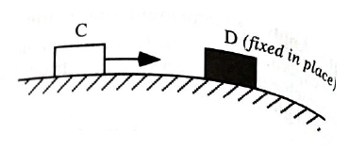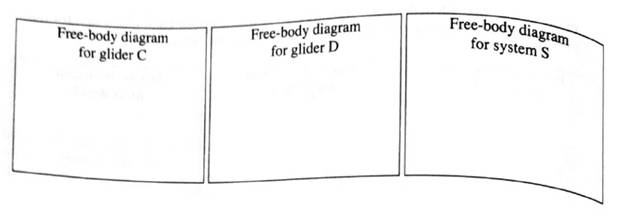
Tutorials in Introductory Physics
1st Edition
ISBN: 9780130970695
Author: Peter S. Shaffer, Lillian C. McDermott
Publisher: Addison Wesley
expand_more
expand_more
format_list_bulleted
Concept explainers
Textbook Question
Chapter 3.3, Problem 2bT
A second experiment is performed in which glider D is fixed in place. Glider C is launched toward glider D with the same velocity as in the first experiment, and it rebounds with the same speed that it had initially.

- In the spaces provided, draw separate free-body diagrams for each glider and for the system of the two gliders at an instant during the collision in this second experiment.

Explain how the fact that glider D is fixed in place is reflected in your free-body diagrams.
Expert Solution & Answer
Learn your wayIncludes step-by-step video

schedule07:24
Students have asked these similar questions
Fresnel lens: You would like to design a 25 mm diameter blazed Fresnel zone plate with a first-order power of
+1.5 diopters. What is the lithography requirement (resolution required) for making this lens that is designed
for 550 nm? Express your answer in units of μm to one decimal point.
Fresnel lens: What would the power of the first diffracted order of this lens be at wavelength of 400 nm?
Express your answer in diopters to one decimal point.
Eye: A person with myopic eyes has a far point of 15 cm. What power contact lenses does she need to correct
her version to a standard far point at infinity? Give your answer in diopter to one decimal point.
Paraxial design of a field flattener. Imagine your optical system has Petzal curvature of the field with radius
p. In Module 1 of Course 1, a homework problem asked you to derive the paraxial focus shift along the axis
when a slab of glass was inserted in a converging cone of rays. Find or re-derive that result, then use it to
calculate the paraxial radius of curvature of a field flattener of refractive index n that will correct the observed
Petzval. Assume that the side of the flattener facing the image plane is plano. What is the required radius of
the plano-convex field flattener? (p written as rho )
3.37(a) Five free electrons exist in a three-dimensional infinite potential well with all three widths equal to \( a = 12 \, \text{Å} \). Determine the Fermi energy level at \( T = 0 \, \text{K} \). (b) Repeat part (a) for 13 electrons.
Book: Semiconductor Physics and Devices 4th ed, NeamanChapter-3Please expert answer only. don't give gpt-generated answers, & please clear the concept of quantum states for determining nx, ny, nz to determine E, as I don't have much idea about that topic.
Chapter 3 Solutions
Tutorials in Introductory Physics
Ch. 3.1 - A block is moving to the left on a frictionless,...Ch. 3.1 - In a separate experiment, two hands push...Ch. 3.1 - Shown at right is a side-view diagram of the...Ch. 3.1 - Recall the motion of the block in part B. For each...Ch. 3.1 - Generalize from your answers to pans A—D to...Ch. 3.1 - A glider, glider A, Is pulled by a suing across a...Ch. 3.1 - The diagrams at right show two identical gliders...Ch. 3.1 - A block on a frictionless table is connected to a...Ch. 3.2 - Three students discuss the final momentum and...Ch. 3.2 - Which cart takes longer to travel between the two...
Ch. 3.2 - Use Newton's second law and the definition of...Ch. 3.2 - How does the net work done on cart A(Wnet,A)...Ch. 3.2 - Refer again to the discussion among the three...Ch. 3.2 - Release the ball so that it rolls straight toward...Ch. 3.2 - Release the ball at an angle to the ramp as shown...Ch. 3.2 - How does the direction of the net force on the...Ch. 3.2 - How does the change in kinetic energy of the ball...Ch. 3.2 - For motion 1, draw vector in region II of the...Ch. 3.2 - For motion 2, draw vectors in region II of the...Ch. 3.2 - Consider the change in momentum vectors you...Ch. 3.3 - What differences between gliders M and N could...Ch. 3.3 - For experiment 1,draw and label separate free-body...Ch. 3.3 - In the spaces provided, draw and label vectors to...Ch. 3.3 - A student compares the final speeds of gliders M...Ch. 3.3 - A. Suppose that glider D is free to move and...Ch. 3.3 - A second experiment is performed in which glider D...Ch. 3.3 - Consider the two experiments described above. When...Ch. 3.3 - When the momentum of an object or system of...Ch. 3.3 - Two students the second experiment, in which...Ch. 3.4 - Draw separate free-body diagrams for each block...Ch. 3.4 - Rank the magnitudes of all the horizontal forces...Ch. 3.4 - The velocity vectors for blocks A and B are shown...Ch. 3.4 - Use your knowledge of the velocities and changes...Ch. 3.4 - Draw and label a free-body diagram for system C at...Ch. 3.4 - Write an equation for the momentum of system C in...Ch. 3.4 - Generalize from your results to answer the...Ch. 3.4 - Imagine a single object whose mass is equal to the...Ch. 3.4 - What are the external forces exerted on system C...Ch. 3.4 - The momentum vectors of each block before the...Ch. 3.4 - Draw arrows that represent the direction of the...
Additional Science Textbook Solutions
Find more solutions based on key concepts
Hydrogen gas can be prepared in the laboratory by a single-displacement reaction in which solid zinc reacts wit...
Introductory Chemistry (6th Edition)
Why are BSL-4 suits pressurized? Why not just wear tough regular suits?
Microbiology with Diseases by Body System (5th Edition)
1. Which parts of the skeleton belong to the appendicular skeleton? Which belong to the axial skeleton?
Human Anatomy & Physiology (2nd Edition)
1. Define and distinguish incomplete penetrance and variable expressivity.
Genetic Analysis: An Integrated Approach (3rd Edition)
Using the pKa values listed in Table 15.1, predict the products of the following reactions:
Organic Chemistry (8th Edition)
Which of the following factors would tend to increase membrane fluidity? A. a greater proportion of unsaturated...
Campbell Biology in Focus (2nd Edition)
Knowledge Booster
Learn more about
Need a deep-dive on the concept behind this application? Look no further. Learn more about this topic, physics and related others by exploring similar questions and additional content below.Similar questions
- 3.37(a) Five free electrons exist in a three-dimensional infinite potential well with all three widths equal to \( a = 12 \, \text{Å} \). Determine the Fermi energy level at \( T = 0 \, \text{K} \). (b) Repeat part (a) for 13 electrons. Book: Semiconductor Physics and Devices 4th ed, NeamanChapter-3Please expert answer only. don't give gpt-generated answers, & please clear the concept of quantum states for determining nx, ny, nz to determine E, as I don't have much idea about that topic.arrow_forwardNo chatgpt pls will upvotearrow_forwardUse the following information to answer the next question. Two mirrors meet an angle, a, of 105°. A ray of light is incident upon mirror A at an angle, i, of 42°. The ray of light reflects off mirror B and then enters water, as shown below: Incident ray at A Note: This diagram is not to scale. a Air (n = 1.00) Water (n = 1.34) 1) Determine the angle of refraction of the ray of light in the water. Barrow_forward
- Hi can u please solvearrow_forward6. Bending a lens in OpticStudio or OSLO. In either package, create a BK7 singlet lens of 10 mm semi-diameter and with 10 mm thickness. Set the wavelength to the (default) 0.55 microns and a single on-axis field point at infinite object distance. Set the image distance to 200 mm. Make the first surface the stop insure that the lens is fully filled (that is, that the entrance beam has a radius of 10 mm). Use the lens-maker's equation to calculate initial glass curvatures assuming you want a symmetric, bi-convex lens with an effective focal length of 200 mm. Get this working and examine the RMS spot size using the "Text" tab of the Spot Diagram analysis tab (OpticStudio) or the Spd command of the text widnow (OSLO). You should find the lens is far from diffraction limited, with a spot size of more than 100 microns. Now let's optimize this lens. In OpticStudio, create a default merit function optimizing on spot size.Then insert one extra line at the top of the merit function. Assign the…arrow_forwardNo chatgpt pls will upvote Already got wrong chatgpt answer .arrow_forward
- Use the following information to answer the next question. Two mirrors meet an angle, a, of 105°. A ray of light is incident upon mirror A at an angle, i, of 42°. The ray of light reflects off mirror B and then enters water, as shown below: A Incident ray at A Note: This diagram is not to scale. Air (n = 1.00) Water (n = 1.34) Barrow_forwardUse the following information to answer the next question. Two mirrors meet an angle, a, of 105°. A ray of light is incident upon mirror A at an angle, i, of 42°. The ray of light reflects off mirror B and then enters water, as shown below: A Incident ray at A Note: This diagram is not to scale. Air (n = 1.00) Water (n = 1.34) Barrow_forwardGood explanation it sure experts solve it.arrow_forward
- No chatgpt pls will upvote Asaparrow_forwardA satellite has a mass of 100kg and is located at 2.00 x 10^6 m above the surface of the earth. a) What is the potential energy associated with the satellite at this loction? b) What is the magnitude of the gravitational force on the satellite?arrow_forwardNo chatgpt pls will upvotearrow_forward
arrow_back_ios
SEE MORE QUESTIONS
arrow_forward_ios
Recommended textbooks for you
 Principles of Physics: A Calculus-Based TextPhysicsISBN:9781133104261Author:Raymond A. Serway, John W. JewettPublisher:Cengage Learning
Principles of Physics: A Calculus-Based TextPhysicsISBN:9781133104261Author:Raymond A. Serway, John W. JewettPublisher:Cengage Learning Classical Dynamics of Particles and SystemsPhysicsISBN:9780534408961Author:Stephen T. Thornton, Jerry B. MarionPublisher:Cengage Learning
Classical Dynamics of Particles and SystemsPhysicsISBN:9780534408961Author:Stephen T. Thornton, Jerry B. MarionPublisher:Cengage Learning Physics for Scientists and Engineers, Technology ...PhysicsISBN:9781305116399Author:Raymond A. Serway, John W. JewettPublisher:Cengage Learning
Physics for Scientists and Engineers, Technology ...PhysicsISBN:9781305116399Author:Raymond A. Serway, John W. JewettPublisher:Cengage Learning University Physics Volume 1PhysicsISBN:9781938168277Author:William Moebs, Samuel J. Ling, Jeff SannyPublisher:OpenStax - Rice University
University Physics Volume 1PhysicsISBN:9781938168277Author:William Moebs, Samuel J. Ling, Jeff SannyPublisher:OpenStax - Rice University Glencoe Physics: Principles and Problems, Student...PhysicsISBN:9780078807213Author:Paul W. ZitzewitzPublisher:Glencoe/McGraw-Hill
Glencoe Physics: Principles and Problems, Student...PhysicsISBN:9780078807213Author:Paul W. ZitzewitzPublisher:Glencoe/McGraw-Hill Physics for Scientists and Engineers: Foundations...PhysicsISBN:9781133939146Author:Katz, Debora M.Publisher:Cengage Learning
Physics for Scientists and Engineers: Foundations...PhysicsISBN:9781133939146Author:Katz, Debora M.Publisher:Cengage Learning

Principles of Physics: A Calculus-Based Text
Physics
ISBN:9781133104261
Author:Raymond A. Serway, John W. Jewett
Publisher:Cengage Learning

Classical Dynamics of Particles and Systems
Physics
ISBN:9780534408961
Author:Stephen T. Thornton, Jerry B. Marion
Publisher:Cengage Learning

Physics for Scientists and Engineers, Technology ...
Physics
ISBN:9781305116399
Author:Raymond A. Serway, John W. Jewett
Publisher:Cengage Learning

University Physics Volume 1
Physics
ISBN:9781938168277
Author:William Moebs, Samuel J. Ling, Jeff Sanny
Publisher:OpenStax - Rice University

Glencoe Physics: Principles and Problems, Student...
Physics
ISBN:9780078807213
Author:Paul W. Zitzewitz
Publisher:Glencoe/McGraw-Hill

Physics for Scientists and Engineers: Foundations...
Physics
ISBN:9781133939146
Author:Katz, Debora M.
Publisher:Cengage Learning